1994 BUICK PARK AVENUE oil pressure
[x] Cancel search: oil pressurePage 14 of 324
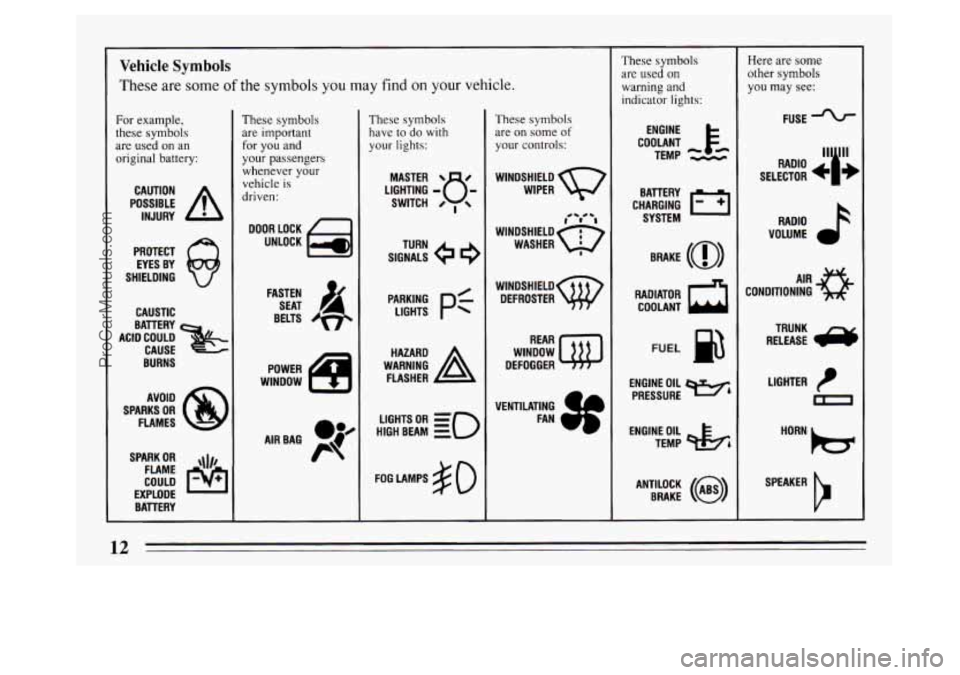
Vehicle Symbols
These are some of the symbols you may find on your vehicle.
For example,
these symbols are used on an
original battery:
POSSIBLE A
CAUTION
INJURY
PROTECT EYES BY
SHIELDING
CAUSTIC
BURNS AVOID
SPARKS
OR
FLAMES
SPARK
OR ,111,
COULD FLAME
EXPLODE BATTERY
These symbols are important
for you and
your passengers
whenever your
vehicle
is
driven:
DOOR LOCK
UNLOCK
FASTEN SEAT
4
BELTS
POWER
WINDOW
These symbols
have to
do with
your lights:
WARNING A
HAZARD
FLASHER
HIGH BEAM OR
= -0
FOG LAMPS $0
These symbols
are on some
of
your controls:
WINoSHIELD WIPER w
WINDSHIELD
DEFROSTER
WINDOW
DEFOGGER
VENTILATING FAN
These symbols
are
used on
warning and indicator lights:
CHARGING 1-1
BATTERY
SYSTEM
RADIATOR
a
COOLANT
FUEL
ENGINE OIL
PRESSURE
Wb
TEMP OIL &
ANTILOCK (a)
BRAKE
Here are some
other symbols you may see:
FUSE
RADIO
"i"
SELECTOR fi
RADIO >
VOLUME
LIGHTER
n
12
ProCarManuals.com
Page 127 of 324
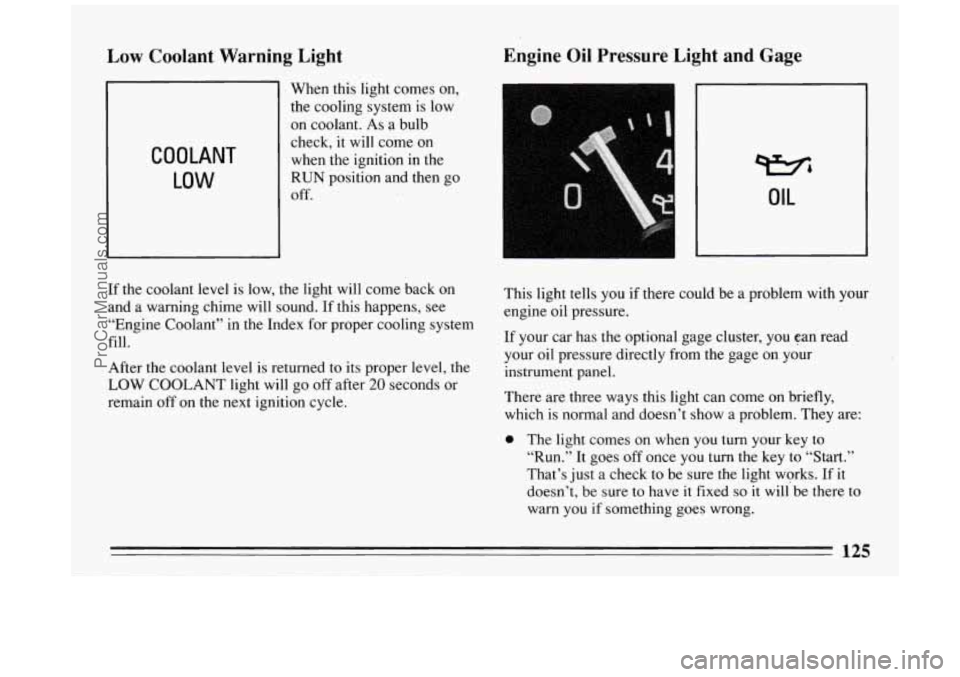
Low Coolant Warning Light Engine
Oil Pressure Light and Gage
COOLANT
LOW
When this light comes on,
the cooling system is low
on coolant. As a bulb
check, it will come on
when the ignition in the
RUN position and then go
Off.
Wb
OIL
If the coolant level is low, the light will come back on
and
a warning chime will sound. If this happens, see
“Engine Coolant’’ in the Index for proper cooling system
fill.
After the coolant level is returned to its proper level, the
LOW COOLANT light will go off after 20 seconds or
remain off
on the next ignition cycle. This
light
tells you if there could be a problem with your
engine oil pressure.
If your car has the optional gage cluster, you can read
your oil pressure directly from the gage on your
instrument panel.
There are three ways this light can come on briefly,
which
is normal and doesn’t show a problem. They are:
0 The light comes on when you turn your key to
“Run.”
It goes off once you turn the key to “Start.”
That’s just a check
to be sure the light works. If it
doesn’t, be sure
to have it fixed so it willbe there to
warn you if something goes wrong.
125
ProCarManuals.com
Page 183 of 324
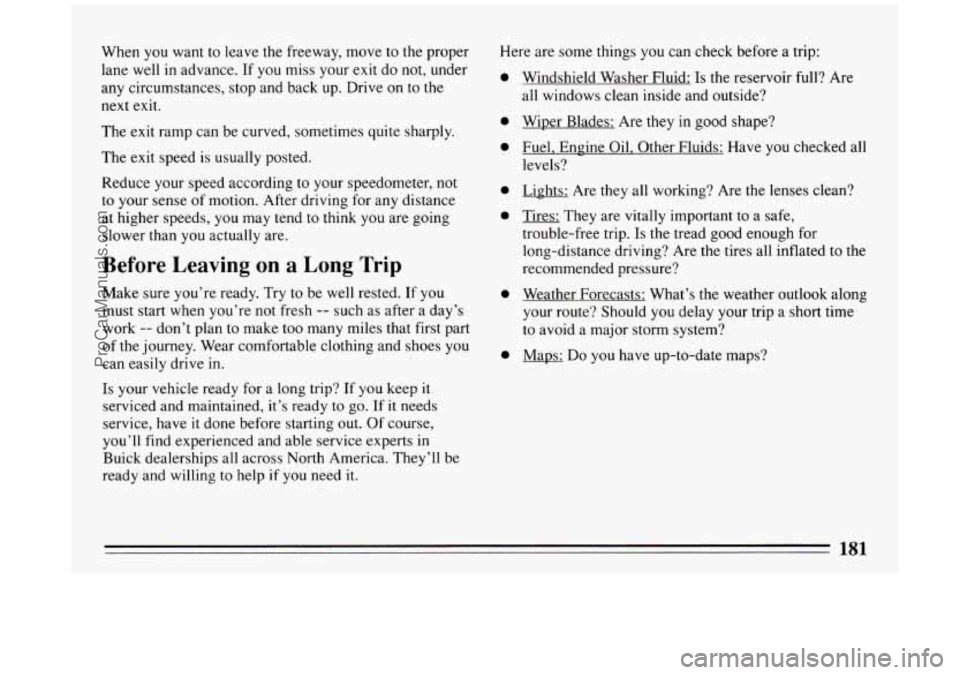
When you want to leave the freeway, move to the proper
lane well
in advance. If you miss your exit do not, under
any circumstances, stop and back up. Drive on to the
next
exit.
The exit ramp can be curved, sometimes quite sharply.
The exit speed
is usually posted.
Reduce your speed according to your speedometer, not
to your sense of motion. After driving for any distance
at higher speeds, you may tend to think you are going
slower than you actually are.
Before Leaving on a Long Trip
Make sure
you’re ready. Try to be well rested. If you
must start when you’re not fresh
-- such as after a day’s
work
-- don’t plan to make too many miles that first part
of the journey. Wear comfortable clothing and shoes you
can easily drive in.
Is your vehicle ready for a long trip? If you keep it
serviced and maintained, it’s ready to go. If it needs
service, have it done before starting out.
Of course,
you’ll find experienced and able service experts in
Buick dealerships all across North America. They’ll be
ready and willing to help
if you need it.
Here are some things you can check before a trip:
0
0
0
0
0
0
0
Windshield Washer Fluid: Is the reservoir full? Are
all windows clean inside and outside?
Wiper Blades: Are they
in good shape?
Fuel, Engine Oil, Other Fluids: Have you checked all
levels?
Lights: Are they all working? Are
the lenses clean?
Tires: They are vitally important
to a safe,
trouble-free trip.
Is the tread good enough for
long-distance driving? Are the tires all inflated to the
recommended pressure?
Weather Forecasts: What’s the weather outlook along
your route? Should
you delay your trip a short time
to avoid a major storm system?
Maps:
Do you have up-to-date maps?
181
ProCarManuals.com
Page 271 of 324
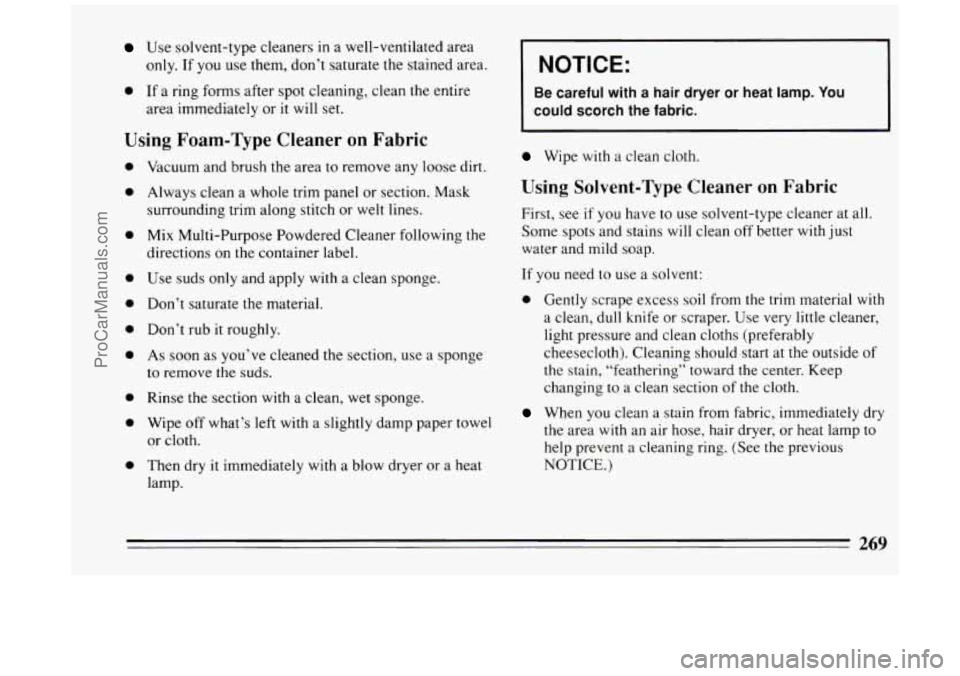
Use solvent-type cleaners in a well-ventilated area
only. If
you use them, don’t saturate the stained area.
0 If a ring forms after spot cleaning, clean the entire
area immediately or
it will set.
Using Foam-Type Cleaner on Fabric
0 Vacuum and brush the area to remove any loose dirt.
0 Always clean a whole trim panel or section. Mask
surrounding trim along stitch or welt lines.
0 Mix Multi-Purpose Powdered Cleaner following the
directions on the container label.
0 Use suds only and apply with a clean sponge.
0 Don’t saturate the material.
0 Don’t rub it roughly.
0 As soon as you’ve cleaned the section, use a sponge
to remove the suds.
0 Rinse the section with a clean, wet sponge.
0 Wipe off what’s left with a slightly damp paper towel
or cloth.
0 Then dry it immediately with a blow dryer or a heat
lamp.
I NOTICE:
I
Be careful with a hair dryer or heat lamp. You
could scorch the fabric.
Wipe with a clean cloth.
Using Solvent-Type Cleaner on Fabric
First, see if you have to use solvent-type cleaner at all.
Some spots and stains will clean off better
with just
water and mild soap.
If you need to use a solvent:
0 Gently scrape excess soil from the trim material with
a clean, dull knife or scraper. Use very little cleaner,
light pressure and clean cloths (preferably
cheesecloth). Cleaning should start at the outside of
the stain, “feathering” toward
the center. Keep
changing to a clean section of the cloth.
When you clean a stain from fabric, immediately dry
the area with an air hose, hair dryer, or heat lamp to
help prevent a cleaning ring. (See the previous
NOTICE.)
269
ProCarManuals.com
Page 295 of 324
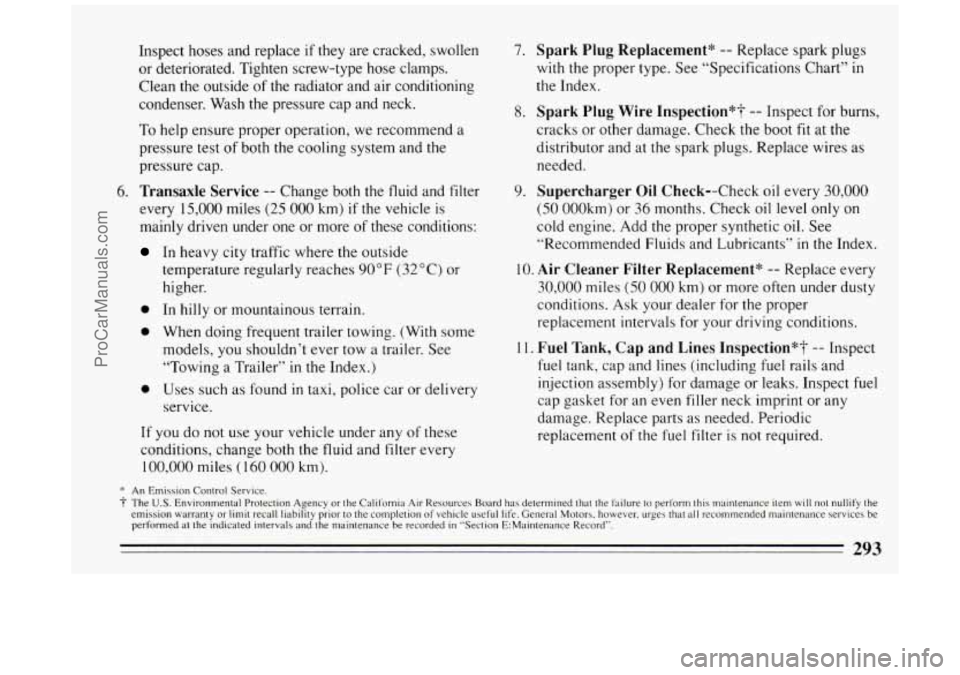
Inspect hoses and replace if they are cracked, swollen
or deteriorated. Tighten screw-type hose clamps.
Clean the outside of the radiator and air conditioning
condenser. Wash the pressure cap and neck.
To help ensure proper operation, we recommend a
pressure test of both the cooling system and the
pressure cap.
6.
Transaxle Service -- Change both the fluid and filter
every
15,000 miles (25 000 km) if the vehicle is
mainly driven under one or more
of these conditions:
In heavy city traffic where the outside
temperature regularly reaches
90°F (32°C) or
higher.
0 In hilly or mountainous terrain.
0 When doing frequent trailer towing. (With some
models, you shouldn’t ever tow a trailer. See
“Towing a Trailer”
in the Index.)
0 Uses such as found in taxi, police car or delivery
service.
If you do not use your vehicle under any of these
conditions, change both the fluid and filter every
100,000 miles ( 160 000 km).
7. Spark Plug Replacement* -- Replace spark plugs
with the proper type. See “Specifications Chart”
in
the Index.
8. Spark Plug Wire Inspection*-f -- Inspect for burns,
cracks or other damage. Check the boot
fit at the
distributor and at the spark plugs. Replace wires as
needed.
9. Supercharger Oil Check--Check oil every 30,000
(50 000km) or 36 months. Check oil level only on
cold engine. Add the proper synthetic oil. See
“Recommended Fluids and Lubricants” in the Index.
10. Air Cleaner Filter Replacement* -- Replace every
30,000 miles (50 000 km) or more often under dusty
conditions. Ask your dealer for the proper
replacement intervals for your driving conditions.
1 1. Fuel Tank, Cap and Lines Inspection*? -- Inspect
fuel tank, cap and lines (including fuel rails and
injection assembly) for damage or leaks. Inspect fuel
cap gasket for an even filler neck imprint or any
damage. Replace parts as needed. Periodic
replacement
of the fuel filter is not required.
* An Emission Control Service.
-f The US. Environmental Protection Agency or the California Air Resources Board has determined that the failure to perform this maintenance item will not nullify the
emission warranty or limit recall liability prior to the completion of vehicle useful life. General Motors. however. urges that all recommended maintenance services be
performed at the indicated intervals and the maintenance be recorded in “Section E:Maintenance Record”.
293
ProCarManuals.com
Page 315 of 324
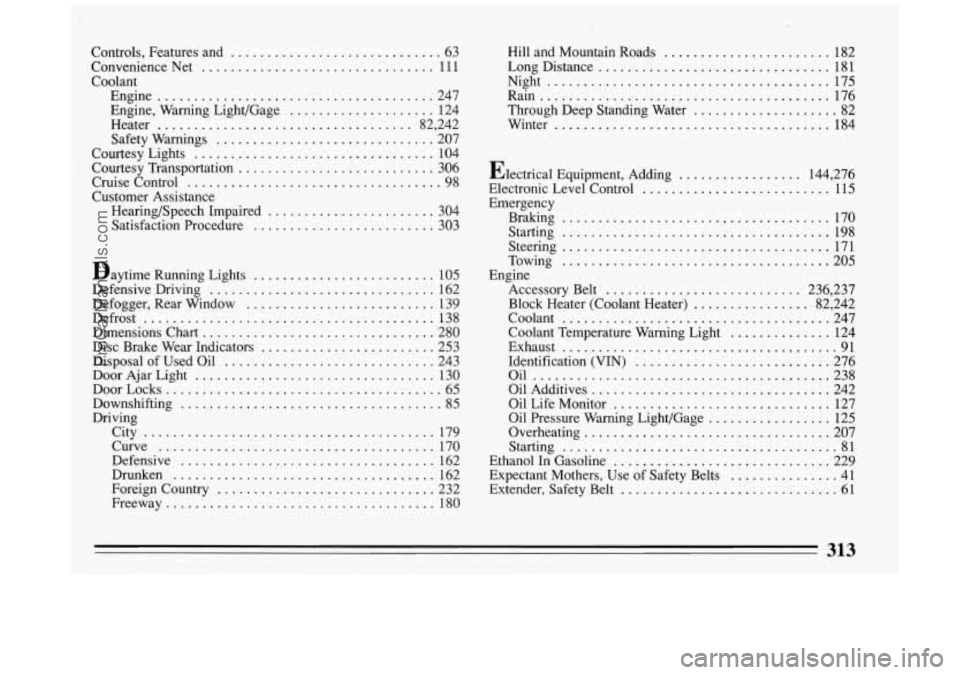
I
Controls. Features and ............................. 63
Convenience Net ................................ 111
Coolant Engine
...................................... 247
Engine. Warning Light/Gage
.................... 124
Heater
................................... 82. 242
Safety Warnings
.............................. 207
Courtesy Lights
................................. 104
Courtesy Transportation
........................... 306
Cruise Control
................................... 98
Customer Assistance Hearing/Speech Impaired
....................... 304
Satisfaction Procedure
......................... 303
Daytime Running Lights
......................... 105
Defensive Driving
............................... 162
Defogger. Rear Window
.......................... 139
Defrost
........................................ 138
Dimensions Chart
................................ 280
Disc Brake Wear Indicators
........................ 253
Disposal of Used Oil
............................. 243
Door Ajar Light
................................. 130
DoorLocks
...................................... 65
Downshifting
..................................... 85
Driving City
........................................ 179
Curve
...................................... 170
Defensive
................................... 162
Drunken
.................................... 162
Foreign Country
.............................. 232
Freeway
..................................... 180 Hill
and Mountain Roads
....................... 182
Long Distance
................................ 181
Night
....................................... 175
Rain
........................................ 176
Through Deep Standing Water
.................... 82
Winter
...................................... 184
Electrical Equipment. Adding
................. 144. 276
Electronic Level Control
.......................... 115
Emergency
Braking
..................................... 170
Starting
..................................... 198
Steering
..................................... 171
Towing
..................................... 205
Accessory Belt
........................... 236, 237
Block Heater (Coolant Heater)
................ 82, 242
Coolant
..................................... 247
Engine
Coolant Temperature Warning Light
.............. 124
Exhaust
....................
Identification (VIN) ..........
Oil ........................
Oil Additives ................
Oil Life Monitor .............
Oil Pressure Warning Light/Gage
Overheating
.................
Starting ....................
.................. 91
................. 276
................. 238
................. 242
................. 127
................. 125
................. 207
.................. 81
Ethanol IiGasoline
.............................. 229
Extender. Safety Belt
.............................. 61
Expectant
Mothers. Use of Safety Belts
............... 41
313
ProCarManuals.com